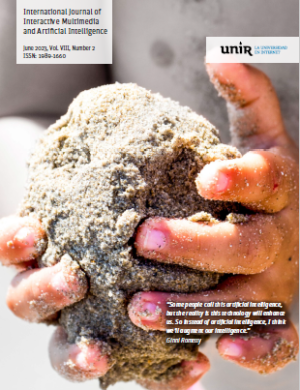Resource and Process Management With a Decision Model Based on Fuzzy Logic.
DOI:
https://doi.org/10.9781/ijimai.2023.02.009Keywords:
Operator, Communications, Computing, Fuzzy Logic, Mutual Exclusion, Operating SystemAbstract
The allocation of the resources to be shared in the context of a distributed processing system needs to be coordinated through the mutual exclusion mechanism, which will decide the order in which the shared resources will be allocated to those processes that require them. This paper proposes an aggregation operator, which can be used by a module that manages the shared resources, whose function is to assign the resources to the processes according to their requirements (shared resources) and the status of the distributed nodes in which the processes operate (computational load), by using 2-tuple associated to linguistic labels.
Downloads
References
A. S. Tanenbaum, Sistemas Operativos Distribuidos, México: Prentice - Hall Hispanoamericana S.A., 1996.
A. S. Tanenbaum, Sistemas Operativos Modernos. 3ra. Edición: México, Pearson Educación S. A., 2009.
D. Agrawal, A. El Abbadi, “An Efficient and Fault-Tolerant Solution of Distributed Mutual Exclusion,” ACM Transactions on Computer Systems. Vol. 9, USA, 1991 pp. 1-20.
G. Ricart, A. K. Agrawala, “An Optimal Algorithm for Mutual Exclusion in Computer Networks”. Communication of the ACM. Vol. 24, USA, 1981, pp. 9-17.
G. Cao, M. Singhal, “A Delay-Optimal Quorum-Based Mutual Exclusion Algorithm for Distributed Systems”. IEEE Transactions on Parallel and Distributed Systems. Vol. 12, no. 12, USA, 2001, pp. 1256-1268.
S. Lodha, A. Kshemkalyani, “A Fair Distributed Mutual Exclusion Algorithm”. IEEE Transactions on Parallel and Distributed Systems. Vol. 11, no. 6, USA, 2000, pp. 537-549.
W. Stallings, Sistemas Operativos. 5ta. Edición. Madrid, España, Pearson Educación S.A., 2005.
G. Andrews, Foundation of Multithreaded, Parallel, and Distributed Programming. Reading, MA, USA, Addison Wesley, 2000.
R. Guerraoui, L. Rodrigues, Introduction to Reliable Distributed Programming. Springer-Verlag, Berlin, Germany, 2006.
N. Lynch, Distributed Algorithms, San Mateo, CA, USA, Morgan Kauffman, 1996.
G. Tel, Introduction to Distributed Algorithms. 2nd ed., Cambridge, UK, Cambridge University Press, 2000.
H. Attiya, J. Welch, Distributed Computing Fundamentals, Simulations, and Advanced Topics, 2nd ed., New York, USA, John Wiley, 2004.
P. Saxena, J. Rai, “A Survey of Permission-based Distributed Mutual Exclusion Algorithms”. Computer Standards and Interfaces, vol. (25)2, pp 159-181, 2003.
M. Velazquez, “A Survey of Distributed Mutual Exclusion Algorithms”. Technical Report CS-93-116, University of Colorado at Boulder, 1993.
S.-D. Lin, Q. Lian, M. Chen, Z. Zhang, “A Practical Distributed Mutual Exclusion Protocol in Dynamic Peer-to-Peer Systems”. Proceeding of the Third International Workshop on Peer-to-Peer Systems, vol. 3279 of Lecture Notes in Computer Sciences, (La Jolla, CA). Springer-Verlag, Berlin, 2004.
L. Sha, R. Rajkumar, J. P. Lehoczky, “Priority inheritance protocols: An approach to real-time synchronization”. Computers, IEEE Transactions on, vol. 39(9), pp. 1175–1185, 1990.
F. Agostini, D. L. La Red Martínez, J. C. Acosta. “Modeling of the consensus in the allocation of resources in distributed systems”. International Journal of Advanced Computer Science and Applications (IJACSA). The Science and Information (SAI) Organization, England, U.K. Vol. 9, no. 12., 2018.
L. A. Zadeh, “The Concept of a Linguistic Variable and its Application to Approximate Reasoning-I”, Information Sciences, Volume 8, Issue 3, pp 199-249, 1975, DOI: 10.1016/0020-0255(75)90036-5.
C. González García, E. R. Núñez-Valdez, V. García-Díaz, B. C. Pelayo G Bustelo, J. M. Cueva Lovelle, “A Review of Artificial Intelligence in the Internet of Things”, International Journal of Interactive Multimedia and Artificial Intelligence - IJIMAI Journal, 2019, DOI: 10.9781/ijimai.2018.03.004
L. A. Zadeh, “Fuzzy Logic = Computing with Words”, IEEE Transactions On Fuzzy Systems, VOL. 4, NO. 2, 103-111, 1996.
Ta-Chun Wen, Kuei-Hu Chang, Hsin-Hung Lai, “Integrating the 2-tuple linguistic representation and soft set to solve supplier selection problems with incomplete information”, Engineering Applications of Artificial Intelligence, Vol. 87, January 2020.
Jerry M. Mendel, “Computing with Words: Zadeh, Turing, Popper and Occam”, IEEE Computational Intelligence Magazine, pp 10-17, November 2007.
F. Herrera, L. Martinez. “An Approach For Combining Linguistic And Numerical Information Based On The 2-Tuple Fuzzy Linguistic Representation Model In Decision-Making”. International Journal of Uncertainty, Fuzziness and Knowledge-Based Systems, Vol. 8, No. 5, pp 539-562, 2000.
F. Herrera, L. Martínez, “A 2-Tuple Fuzzy Linguistic Representation Model for Computing with Words”. IEEE Transactions On Fuzzy Systems, VOL. 8, NO. 6, pp. 746-752, December 2000.
F. Herrera, E. Herrera-Viedma, S. Alonso, F. Chiclana: “Computing with Words in Decision Making: Foundations, Trends and Prospects”, Fuzzy Optimization and Decision Making, 8, 337-364, 2009 (ISSN: 1568-4539). doi:10.1007/s10700-009-9065-2.
S. Zapata, D. Fuentealba, G. Valenzuela. “Aplicación del modelo de representación de información lingüística 2-tuplas con información multigranular”. Revista Trilogía: Ciencia, Tecnología y Sociedad. Vol. 27, Nº 37, pp 110-127, July 2015. Facultad de Ingeniería UTEM.
Jiménez, G.E. and Zulueta, Y., “A 2-tuple linguistic multi-period decision making approach for dynamic green supplier selection”. DYNA, 84(202), pp. 199-206, September 2017.
M. Ying. “A Formal Model of Computing With Words”. IEEE Transactions On Fuzzy Systems, VOL. 10, N° 5, October 2002.
J. Liu, L. Yi and Z. Pei, “A new linguistic term transformation method in linguistic decision making”. Journal of Intelligent & Fuzzy Systems 35, 2403–2412, IOS Press, 2018, DOI: 10.3233/JIFS-17987.
David L. la Red Martínez, “Aggregation Operator for Assignment of Resources in Distributed Systems”, (IJACSA) International Journal of Advanced Computer Science and Applications, Vol. 8, No. 10, 2017.
R. Yager. “On Ordered Weighted Averaging Aggregation Operators in Multi-Criteria Decision Making”. IEEE Transactions On Systems, Man and Cybernetics 18: 183-190, 1988.
R. Yager and G. Pasi. “Modelling Majority Opinion in Multi-Agent Decision Making”. International Conference on Information Processing and Management of Uncertainty in Knowledge-Based Systems, 2002.
F. Herrera and L. Martínez, “A model based on linguistic 2-tuples for dealing with multigranular hierarchical linguistic contexts in multi-expert decision-making,” IEEE Transactions on Systems, Man and Cybernetics. Part B (Cybernetics), vol. 31, no. 2, 2001, doi: 10.1109/3477.915345.
Downloads
Published
-
Abstract176
-
PDF15









